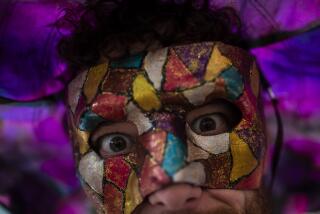Dance & Music : ‘Oba Oba ‘92’ at the Pantages
- Share via
The backdrop shows a parched land under a relentless sun: the Brazilian northeast, where people cope with the painful consequences of prolonged drought. “By singing and dancing,” a narrator tells us, “they find courage and the sadness becomes happiness.”
Indeed it does--so quickly, in fact, that before you can say “chica-boom” the stage is filled with fringed parasols, high-energy celebratory dances and exultant vaulting by what looks like the Brazilian Olympic gymnastic team.
This is, after all, “Oba Oba ‘92,” a revue that can be accused of many things, but never neorealism. Maintaining a delirious emphasis on shedding clothes and inhibitions, the show’s eighth edition opened at the Pantages Theatre on Friday for a five-week run.
As always, “Oba Oba” accepts Carnival excess as the norm, with Carmen Miranda and Antonio Carlos Jobim exalted as Brazil’s cultural grandees and the only costumes worth wearing always blaze with sequins and fluorescent feathers. Finally, for those of us who consider naked Brazilians a wonder of nature eclipsing even the Amazon rain forest, “Oba Oba” offers an opportunity to ogle-ogle and even to conga-conga with the Rio-fantasy of one’s choice.
The current edition boasts, in singer Eliana Estevao, a glamorous, sophisticated centerpiece for the Jobim tribute, and in the duet between Angela Mara and Carlos Leca an example of the tongue-twisting bravado that made Miranda’s performances such a joy. (With its witless costumes and other lapses of style, the actual Miranda sequence, however, continues to be one of the show’s major disappointments.)
Choreographer Roberto Abrahao has reworked the formerly wimpy lambada number into a flamboyant display of grinding hips, molten backbends and jitterbug-style partnering that makes up in sheer force everything it loses in sensuality. Carlos Oliveira, Eliane Garcia and Valeria Matos share the honors for what is now one of the first act’s dance highlights.
Act II remains in thrall to the Capoeira, the Brazilian form of foot fighting that becomes a dance idiom in its most benign form. “Oba Oba ‘92” offers only four very short bouts of potentially lethal circle-kicks, but compensates with an exhilarating gymnastic competition as well as intricate ensemble stick-fighting (Maculele). The guys in dreadlocks prove especially daring but nearly everyone has his own spectacular specialty to flatten the audience.
The sequence opens with a joyous duet or dialogue between Jones Santana and Cobrinha Mansa on the berimbau, Brazil’s distinctive coconut-shell guitar. Between the evening’s parades of pulchritrude, other notable showcases occur for Toco Preto on cavaquinho (small guitar) and Marquinho da Geralda on cuica (slide-drum), as well as an opportunity for virtuoso tambourine-juggling by Edgar Aguiar.
African-Americans may be especially intrigued by “Macumba,” an extended celebration of Brazilian ritual traditions derived from Africa that reveals strong links to the source-culture--and to some forms of North American concert dance as well.
There’s too much lame and other glitz on view to mistake “Macumba” for an anthropological transcription, but both here and in such moments as the brief slavery dance in Act 1 you sense something deeper than Carnival-hedonism. Not nearly enough to make “Oba Oba ‘92” into anything approaching folk dance, of course, but something suggesting that the creators of this blissfully shameless exploitation of samba rhythm and the body beautiful just might be more aware than anyone else of the difference between Carnival illusion and Lenten reality.
More to Read
The biggest entertainment stories
Get our big stories about Hollywood, film, television, music, arts, culture and more right in your inbox as soon as they publish.
You may occasionally receive promotional content from the Los Angeles Times.










